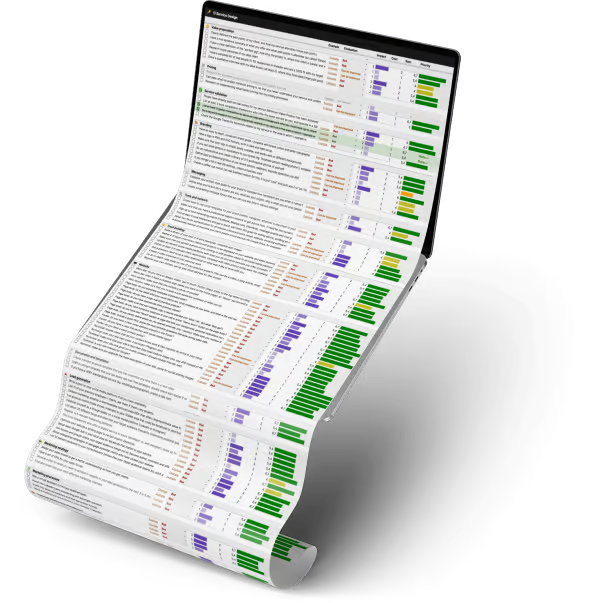How to Build a Stunning Engineering Portfolio in 8 Steps
A stunning engineering portfolio has a simple structure, captivating visuals, and a story behind your work. In this article we will take a closer look at all three!

Updated on
2025-04-21

A stunning engineering portfolio has a simple structure, captivating visuals, and a story behind your work. In this article we will take a closer look at all three!

Updated on
2025-04-21

The first step to building an engineering portfolio requires planning the structure and the design process. This is an opportunity for you to show your creative side and out-of-the-box thinking.
Start by deciding whether your portfolio will be static or dynamic? In other words, do you want to create a set of static pages or a dynamic landing page with creative animations?
Other questions you need to answer at this stage include what’s your budget for this project and whether you want a single-page or a multi-page website to represent your work online. Many engineers opt for simple portfolios in a pdf format, which is another option to consider. We’ll discuss different ways to host your portfolio in step #2. For now, check out this YouTube video by Sam Does Design for some inspiration.
The easiest way to go about making an engineering portfolio is to create a pdf or a Powerpoint presentation. While the simplicity of these portfolio formats can help you land jobs that require such a straightforward approach, there are other options to consider if you’re looking for a more creative outlet.
For instance, you can create a portfolio using GitHub Pages or one of many alternative portfolio-generating websites such as Coroflot, Carbonmade, or Squarespace.
Those who have the right technical skills can build a site from scratch on wordpress.com to unlock unlimited design potential. If you want to go all in, hire an expert to design portfolio pages for you.


Once you decide on the structure and platform behind your mechanical design portfolio, put some thought into what you want to show off. A good portfolio contains more than just the high school you went to and a link to your LinkedIn profile.
What you need is a collection of your most impressive work.
Obviously, if you’re applying for an engineering position your portfolio needs to showcase your most relevant engineering project and the final product that came out of it. Use your portfolio to tell the story behind the design process so that potential employers can pick up on your style and way of work.
Here’s how Frederick Wachter, a mechanical engineer with a focus on robotics, showcases his most important work via simple cards:

Speaking of simple things, your industrial design portfolio needs to be simple and easy to navigate. You don’t want your next potential client to dismiss your proposal because they got lost in a sea of information. To avoid this, free your portfolio of any unnecessary fluff and stick to the most important stuff—your work and the experience that comes along with it.
Whether you’re putting together a PDF or a dynamic website, it’s important to keep the viewer’s experience in mind. Potential employers should be able to navigate your portfolio intuitively. If you look at portfolio templates available on Squarespace or similar websites, you’ll notice they all have one thing in common—a similar navigation bar. That’s because keeping the navigation simple is crucial to keeping the viewer on your site. If you opt for the pdf format, make sure your table of contents is clear and easy to use.
Here’s an example of an engineering portfolio by David S. Miller featuring a simple navigation bar at the top right corner:


Find the low-hanging, quick-wins and 10x your freelancing business!
Get the Client ChecklistAs an engineer, you need to understand the power of personal branding. Your own work and personality serve as your brand, which plays a crucial role in your career. Good branding gives you a chance to leave a positive first impression and have your portfolio stand out among dozens or hundreds of other engineers applying for the new job.
Your work IS your brand.
With that said, make sure to take some time to learn about branding and implement a few tricks. Make sure to use the same branding material across all your social media pages to ensure your online presence is consistent and professional.
Along with consistent branding, your engineering portfolio needs to combine storytelling and visuals. Having too much text with no photos on your site, or vice versa, is a one way ticket to bad portfolio land. You need a good balance between the two to make it work.
Whether you’re working on prototyping, robotics, or aviation, you need to craft interesting and eye-catching visuals that showcase the essence of your work. Here’s an example of good-looking visuals from a CAD (computer-aided design) portfolio:

Once you’ve got your structure and portfolio content laid out, try to add some personality to it. Your portfolio doesn’t have to be a jumble of technical terms and graphics.
It can be so much more than that.
Add some flare to your portfolio website or presentation by adding an About Me section. This is your chance to showcase your personality and impress potential employers with your way of presenting yourself. Here’s an example of effective About Me copywriting done by Roxane Zankel, a product design expert. It shows her beliefs instead of just her work experience.

The final step in creating a successful portfolio that will land you your dream engineering job is to link to your social media pages. If you’re not using social media for business purposes, this is a good time to start.
Social networks such as Instagram and Twitter are huge sources of potential clients. Make sure to utilize them as effectively as possible and don’t forget to use consistent branding material.
Remember Frederick Wachter’s portfolio mentioned earlier? Here’s how he used social icons to link to his pages:

Now that we’ve walked you through the main steps of building an engineering portfolio, it’s up to you to decide which way you want to take this.
There are many questions you need to answer, including how you want to host your portfolio and whether you want to stick with a PDF/Powerpoint or something more advanced.
Either way, these 8 steps will set you on the right path to building an impressive engineering portfolio!

Find the low-hanging, quick-wins and 10x your freelancing business!
Get the Client ChecklistJoin 20.000+ freelancers in our weekly value bomb, and grow your frelance income with confidence!
By entering your email address you acknowledge to subscribe to the FreelancePizza mailing list.
You will be sent a confirmation (opt-in) email to confirm your email. You can unsubscribe any time.
